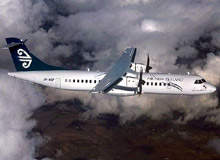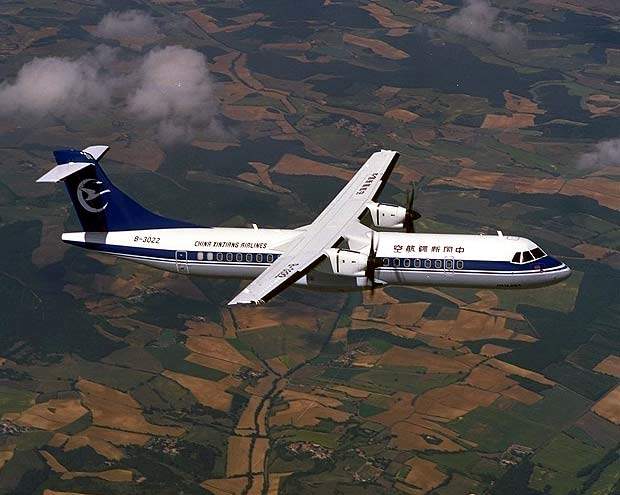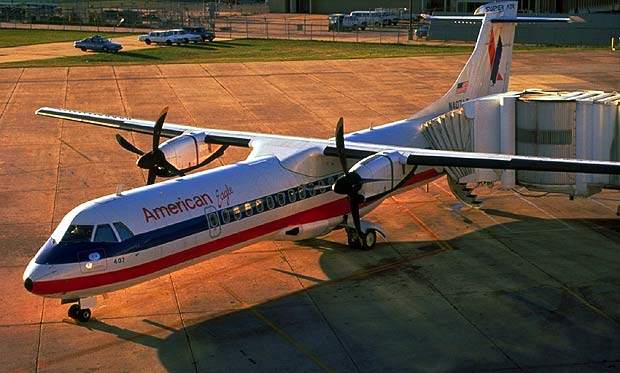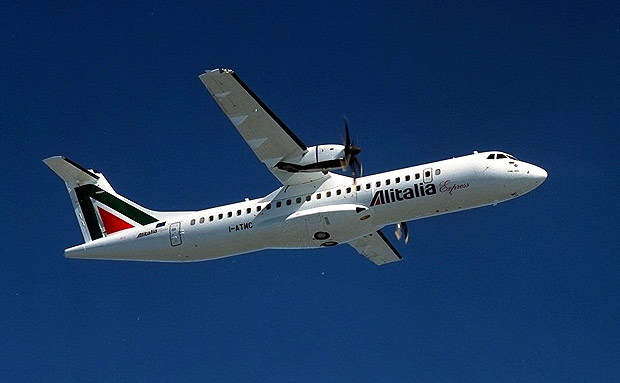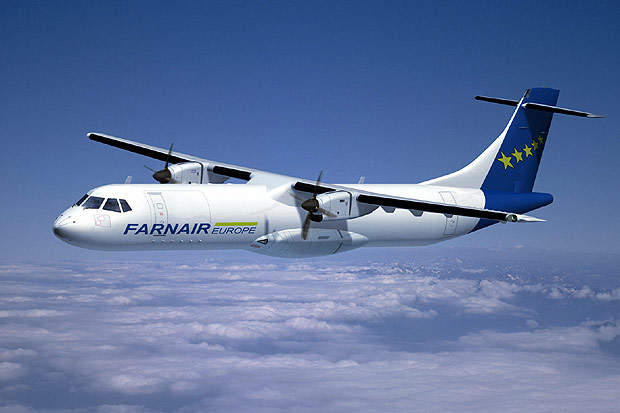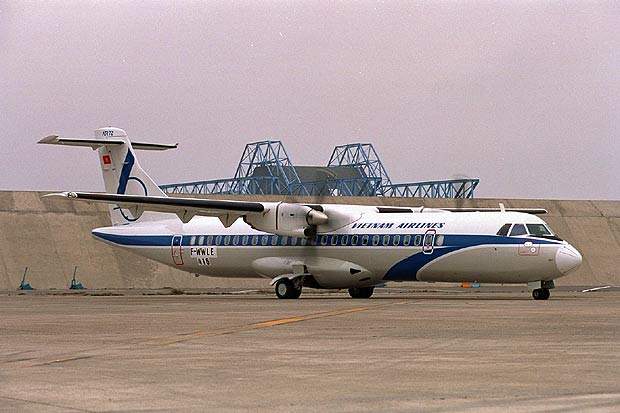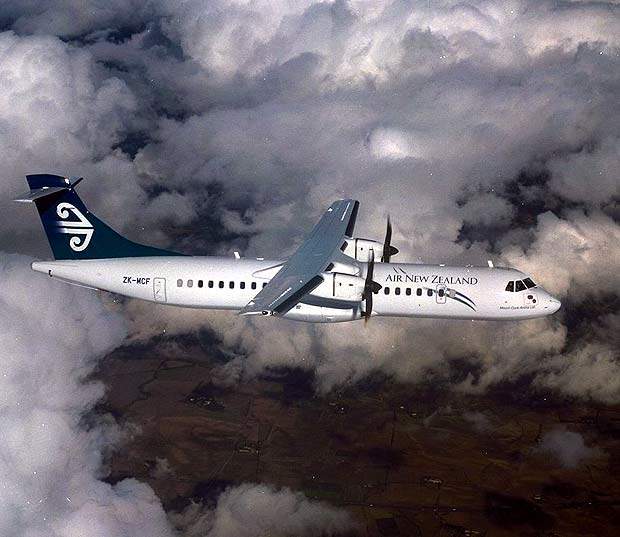The ATR 72 is one of a family of twin-turboprop passenger and freighter aircraft developed and manufactured by Avions de Transport Regional (ATR). ATR, with its headquarters in Toulouse, is a joint venture company between EADS and Finmeccanica / Alenia Aeronautica.
The family consists of the ATR 42 and ATR 72, of which the ATR 42-500 and ATR 72-500 and ATR-600 are the models currently in production. In October 2009, ATR rolled out the new 600 series aircraft.
The ATR 72-600 received the European Aviation Safety Agency (EASA) certification in May 2011. It entered into service in August 2011 with Royal Air Maroc.
The maiden flight of the ATR 72 was completed in October 1988 and the aircraft entered service in October 1989. The ATR 72-500 is certified to operate on unpaved runways by installing a kit to ensure landing gear and lower fuselage protection. Special cold weather procedures allow operations at temperatures as low as -54°C.
The aircraft is certified for low external noise performance according to FAR Part 36 and CH.3 ICAO Annex 16, ensuring compliance well within the current and CH.4 noise regulations. The 500 series features the lowest fuel consumption per passenger and CO2 emissions of regional aviation craft. It was first certified in July 1997.
International orders and deliveries of ATR 72 aircraft
Air Algeria awarded an $82m contract to ATR in December 2009 to supply four ATR 72-500 aircraft. The first of the four aircraft was delivered in February 2010 during a ceremony held at Toulouse. As of June 2011, the ATR 72-500 deliveries to Air Algeria were concluded, increasing the airliner’s fleet to 12.
As of January 2011, 1,074 aircraft (423 ATR 42s and 651 ATR 72s) had been ordered, out of which 915 (412 ATR 42s and 503 ATR 72s) were delivered. In October 2009, Air Vanuatu received the new ATR 72-500, configured with 68 seats and powered by PW 127M engines under a $20.5m contract signed in 2008.
The Royal Thai Air Force received the first of four ATR 72-500 aircraft in September 2009. The contract to purchase four ATR 72-500s was signed in 2007. All the deliveries were completed.
Air Nostrum ordered ten ATR 72-600s in June 2009 and Indonesia’s carrier Wings Air ordered 15 ATR-72 500 series aircraft with an option of 15 more in November 2009 as part of the $600m contract. The first three of the 15 were delivered to Wings Air on 6 January 2010. As of October 2011, the remaining 12 aircraft were in service with Wings Air.
The first aircraft was delivered to Tarom Airlines in May 2009 as part of a $37m contract signed in 2008.
In mid-2009, ATR received 28 new orders for four ATR 42-500, four ATR 42-600, 12 ATR 72-500 and 46 ATR 72-600 from various airlines, including Royal Air Maroc, Afrijet Airlines and Alenia for the Italian Navy. These included four ATR 72-500 aircraft worth $80m ordered by Afrijet Airlines in June 2009. Aurigny Air Services received two ATR 72-500 in March 2009.
In 2008, TAT Group received 40 ATR 72-500. Vietnam Airlines purchased six ATR-500s in 2008. 2007 orders included TRIP Linhas Aereas (seven) in January, Swiftair (three) in April, Malaysia Airlines (20) in June 2007, Batavia (ten) in August, Vietnam Airlines (11), Berjaya Air (four) and Malaysia Airlines (20) in December.
Alenia Aeronautica developed a military variant, the ATR 72 ASW, which integrates the mission system from the ATR 42 maritime patrol aircraft with additional anti-submarine warfare (ASW) systems. In August 2005, the Turkish Navy placed an order for ten ATR-72 ASW aircraft. Deliveries are scheduled to begin in 2012.
In December 2008, Italy placed an order for four ATR72 MP maritime patrol aircraft to be delivered from 2012. The aircraft will be equipped with Selex ATOS mission system, which includes the Seaspray radar and EOST electro-optical multisensor turret.
Caribbean Airlines ordered nine ATR 72-600s in February 2011 at a cost of $200m. The first aircraft was delivered in November 2011.
UTair awarded a $426m contract to ATR in April 2011 to build and deliver 20 ATR 72-500s. Deliveries began in May 2011.
ATR received a $680m order from GE Capital Aviation Services in June 2011 to supply 15 ATR 72-600s (plus 15 optional). Air Lease Corporation placed an order for two ATR 72-600s in September 2011 with deliveries commencing from 2013. UNI Air ordered ten ATR 72-600s in the same month.
Nordic Aviation Capital awarded a $500m contract to ATR in September 2011 to supply ten ATR 72-600s and two ATR 72-500s. Trip Linhas Aereas ordered 18 ATR 72-600s (plus 22 options) in the same month.
ATR was awarded a $270m contract by Air New Zealand Airliner in October 2011 to supply seven ATR 72-600s (plus five options). Deliveries will begin in October 2012 and be completed in 2016. Skywest Airlines ordered five ATR 72-600 aircraft in December 2011 with deliveries scheduled between 2013 and 2014.
ATR 72 turboprop passenger aircraft design features
The aircraft is a high wing monoplane with a semi-monocoque fail-safe fuselage built of light alloy.
Composite materials make up 19% of the total weight of the structure. The composite materials include carbon monolithic structure, carbon / Nomex sandwich and Kevlar / Nomex sandwich, which are used for the main structure including the horizontal tailplane and rudder and the outer wing box section, as well as for the secondary structures, including the aileron, flaps and the engine cowling.
Alenia Aeronautica manufactures the fuselage and tail units and is responsible for the installation of a landing gear. The wings are manufactured and tested at EADS Sogerma in Bordeaux. ATR in Toulouse is responsible for final assembly and delivery to customers.
ATR 72 flight deck and avionics systems
Standard navigation systems satisfy the latest rules and safety requirements, including CAT I AFCS. The ATR aircraft are certified for CAT II ILS operations with an 80ft decision height available as an option.
The ATR navigation system is based on the Honeywell Trimble HT1000 global navigation satellite sensor (GNSS).
The HT1000 GNSS system is coupled with the auto-pilot, the electronic flight instrumentation system (EFIS) and with VHF omnidirectional radio ranging steering guidance with distance measuring equipment data (VOR/DME).
The navigation system is capable of performing all functions associated with ‘great circle’ navigation and permits ‘direct to’ navigation, flight plan navigation and navigation to the nearest airport.
The aircraft is equipped with a Rockwell Collins TTR 921 radar for ACAS II. A Honeywell Primus 660 colour weather radar displays in four colours on the electronic horizontal situation indicator (EHSI).
Weather radar can also be used in MAP mode to display ground obstacles. The Honeywell MARK VIII enhanced ground proximity warning system (E-GPWS) integrates a terrain awareness alerting and display, along with terrain floor clearance on the electronic flight information system (EFIS).
In October 2007, Thales Avionics was selected to provide the digital avionics suite for ATR 72-600 and ATR 42-600 aircraft. The suite includes five LCD displays, new flight management system, new communications, new navigation systems with global navigation satellite system / wide-area augmentation system (GNSS / WAAS) and new automatic pilot for CAT III approaches.
Cabin of the twin-turboprop passenger and freighter aircraft
The ATR 72-500 can carry up to 74 passengers in a four-abreast, centre-aisle configuration. The standard configuration includes two cargo compartments.
The front 5.8m³ cargo compartment is between the flight deck and passenger cabin and the 4.8m³ rear compartment is to the rear of the passenger cabin. The maximum payload is 7,450kg.
Quick-change kit
ATR developed a quick-change kit to provide quick-change capability for both passenger and container transport operations and separately the ATR cargo conversion in order to convert the aircraft to a freighter.
The quick-change kit provides the capability to reconfigure the cabin in 45 minutes to carry ATR-specific containers using the standard front cargo door.
The kit allows the ATR 72 aircraft to be operated as a passenger plane during the day and as a cargo plane during the night. Each optimised container has a 2.8m³ volume and can carry freight up to a total weight of 500kg. ATR 72 can carry up to 13 ATR containers.
ATR 72 cargo conversion kit
Alenia is responsible for the design of the cargo conversion kit which converts the aircraft to a freighter. Aeronavali, a subsidiary of Alenia, is the selected outfitter for the aircraft. All ATR aircraft, ATR 200/300/400/500, can be outfitted with the cargo conversion.
The front standard cargo door measuring 1.52m×1.27m can be optionally replaced by a large cargo door measuring 2.95m×1.8m, enabling the aircraft to carry standard unit load device (ULD) containers such as LD3 and 88in×108in containers.
ATR 72 can carry seven LD3 containers plus 11.7m³ of bulk freight. An alternative load arrangement comprises five 88in×108in containers and an additional 13.3m³ of bulk freight.
Currently, there are 30 ATR cargo aircraft in-service with 12 operators, plus an additional 27 ATR 42 aircraft are under conversion for FedEx. Only two of these aircraft are equipped with the large cargo door: one ATR 72 operated by Farnair and one ATR 42 flown by Northern Air Cargo Alaska.
Turboprop engines used on ATR series aircraft
The ATR aircraft are powered by two PWC 100 Series engines. The ATR 72-500 is powered by two PWC 127F. The maximum continuous thermodynamic power is 2,509kW (3,365shp) and the mechanical power is 2,050kW (2,750shp) for each engine, available up to 45°C.
The 568F six-bladed Hamilton Standard propellers are fitted with propeller electronic control. The blades are all composite counterweighted, the pinner is aluminium and the engine cowlings are of carbon / Nomex sandwich or Kevlar / Nomex sandwich construction. The engine intakes are in Kevlar / Nomex sandwich reinforced with stiffening carbon plies.
The two integral fuel tanks have 5,700l fuel capacity.
The engine air intakes, wing leading edge and horizontal tailplane leading edge are fitted with a pneumatic de-icing system The propeller blades, windshields and horns are equipped with an electrical anti-icing system.
ATR 72 landing gear
The aircraft is fitted with hydraulically retractable tricycle-type landing gear, with Messier landing gear legs, Dunlop wheels and brakes, Crane Hydro-Aire anti-skid control and Michelin tyres. Goodyear tyres are optionally fitted for operations on unpaved runways. A Magnaghi hydraulic system powers the landing gear retraction and also serves other systems in the aircraft.
ATR-600 series details
The 600 series is equipped with a Thales Avionics glass cockpit, new Pratt & Whitney 127M engine and light-emitting diodes (LEDs) lighting in the cabin.
The ATR-600 series provides the flight crew with a paperless cockpit, replacing the current paper-based documentation.
The ATR 72-600 has a new avionics suite including the very latest computer systems for navigational aids, flight data recording, automatic piloting and communications and entailing a better flight interface.
The new cockpit with five LCD screens is also fitted with a new multipurpose computer (MPC) for the optimisation of integration of all systems and improved computing capability.
The five LCD displays include two primary-flight displays, two multifunction displays and one engine and warning display.
The ATR 72-600 can carry up to 70 passengers on a 300nm (550km) sector distance. It can carry up to an additional 500kg on MTOW (maximum take-off weight) and MZFW (maximum zero fuel weight).
The delivery of the 70-seat configured aircraft began in August 2011.
The ATR-72 can cruise at a maximum speed of 518km/h. The range and a service ceiling of the aircraft are 1,500km and 7,620m respectively. The aircraft weighs around 12,950kg and its maximum take-off weight is 22,500kg.

